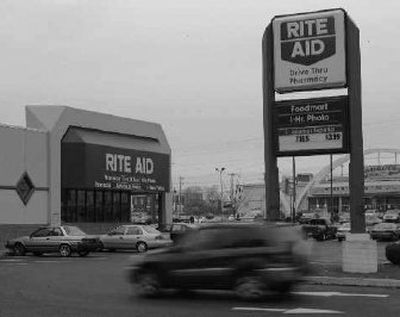Rite Aid poised to expand

HARRISBURG, Pa. — Rite Aid Corp., which began as a single drugstore in northeastern Pennsylvania in 1962 and survived a near-death experience a few years ago, says it is ready for a growth spurt.
Shareholders will vote today on whether to expand the nation’s third-largest drugstore chain by more than half, and make Rite Aid the largest drugstore chain operator on the East Coast. A majority of a quorum of shareholders will be required to enable the deal to go forward.
The deal would represent Rite Aid’s first major acquisition since a turnaround team arrived to save the company from bankruptcy seven years ago — a low point in the company’s history that was brought on by a series of expensive acquisitions.
The latest plan is designed to catapult Rite Aid’s store fleet to within reach of drugstore leaders Walgreen Co. and CVS Corp., but has divided Wall Street analysts and proxy advisers.
Rite Aid would acquire the U.S. Eckerd and Brooks operations of Canada’s Jean Coutu Group Inc. for $1.45 billion in cash and 250 million shares valued at about $1.5 billion, plus the assumption of $850 million in debt.
Rite Aid would still trail Walgreen and CVS in stores and revenue. Some analysts say Rite Aid is going deeper into debt and overpaying for stores that are losing customers and in need of significant upgrades. Others expect Rite Aid to close some of the stores, even if federal anti-trade regulators do not force some divestitures.
Still other analysts say Rite Aid is ready to take on the 1,858 additional stores and spend $950 million over five years that the company says will be required to remerchandise the Brooks and Eckerd stores, convert them to Rite Aid’s systems and rebuild customer loyalty.
Plus, more scale will help Rite Aid compete against rapidly growing competitors in a sector that is reaching beyond the traditional retail pharmacy setting into providing preventive health care, managing pharmacy benefits and sending prescriptions to mail-order customers, some say.
Richard Hastings, senior retail analyst for New York-based credit advisory firm Bernard Sands LLC, said he believes Rite Aid has the savvy to revive the “deteriorating” Eckerd stores and win back customers.
“The solution is to adopt the Rite Aid package from A to Z, and that will prove to be very helpful,” Hastings said.
HSBC Securities analyst Mark Husson said Rite Aid needs to make a move to keep up with CVS and Walgreen. But he questioned whether the wisest choice was to marry two chains that lag industry benchmarks.
“When your own stores are not very productive … and you’re buying some more stores that aren’t very productive, there has to be a question mark whether, as an operator, you’re the best person to manage these less productive stores,” Husson said.
The Federal Trade Commission continues to review the deal. Rite Aid has said it expects the transaction to close shortly after the company’s fourth quarter, which ends March 3.
Should it close unaltered, the deal would create a company of about 5,180 stores in 31 states and Washington, D.C., with revenue of nearly $27 billion and major market shares in the New York City, Philadelphia, Pittsburgh and Baltimore areas.
In the deal, Rite Aid also will acquire six distribution centers and make Jean Coutu the company’s largest shareholder, with a 30.2 percent voting power. Rite Aid has said it expects to cut $150 million in duplicate costs and begin seeing positive earnings after 12 months.
Analysts say Rite Aid’s long-term debt would rocket to approximately $5.8 billion — higher than CVS or Walgreen, and nearly the level it was when chairman Bob Miller and the turnaround team took Rite Aid’s reins in December 1999.
Miller’s team has since stabilized the company, cut debt and revived sales of general merchandise, while six executives from Rite Aid’s prior management pleaded guilty or were convicted in connection with a federal accounting fraud investigation.